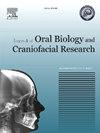Effects of twin-block appliance on quality of life in OSA children with class 2 malocclusion and mandibular retrognathia
Q1 Medicine
Journal of oral biology and craniofacial research
Pub Date : 2025-06-13
DOI:10.1016/j.jobcr.2025.06.003
引用次数: 0
Abstract
Purpose
Twin block has been proposed as a potential oral appliance for the treatment of obstructive sleep apnea (OSA) in children with class 2 skeletal malocclusion. This study aimed to evaluate the impact of twin block appliance on quality of life in children with OSA.
Materials and methods
This case series study comprised 47 growing OSA children with Class 2 skeletal malocclusion and mandibular retrognathia aged 10–12 years. Patients were treated with a functional twin block appliance and the quality of life was assessed using the OSA-18 questionnaire, which was administered before appliance insertion and 30 days after the end of treatment. Additionally, a second standard overnight polysomnography (PSG) was performed to determine changes in respiratory parameters.
Results
All domains of the OSA-18 questionnaire showed significant changes (P < 0.025), except for physical suffering domain (P = 0.075). The mean total scores of the OSA-18 questionnaire decreased from 81.55 to and 53.07 scores (28.49 scores, P < 0.001). At the end of the treatment, the apnea-hypopnea index decreased significantly by 4.53 events/h (74.0 %), P < 0.001).
Conclusion
The twin block appliance resulted in a significant improvement in four of the five domains of the OSA-18 questionnaire, with a positive impact on the quality of life in OSA children with Class 2 skeletal malocclusion. Patients showed significant improvements in respiratory sleep parameters and parent-reported symptoms.
双块矫治器对伴有2级错颌后畸形的OSA患儿生活质量的影响
目的:twin block被认为是治疗2类骨骼错颌儿童阻塞性睡眠呼吸暂停(OSA)的潜在口腔器械。本研究旨在评估双阻滞器对OSA患儿生活质量的影响。材料和方法本病例系列研究包括47例10-12岁的成长期OSA儿童,伴有2类骨骼错颌畸形和下颌后颌畸形。患者接受功能性双块矫治器治疗,并使用OSA-18问卷评估生活质量,问卷在矫治器插入前和治疗结束后30天进行。此外,进行第二次标准夜间多导睡眠图(PSG)以确定呼吸参数的变化。结果OSA-18问卷各域均有显著性变化(P <;0.025),生理痛苦域除外(P = 0.075)。OSA-18问卷平均总分由81.55分下降至53.07分(28.49分,P <;0.001)。治疗结束时,呼吸暂停低通气指数显著降低4.53次/h (74.0%), P <;0.001)。结论双块矫治器可显著改善OSA-18问卷5个领域中的4个,对伴有2类骨骼错颌的OSA患儿的生活质量有积极影响。患者的呼吸睡眠参数和家长报告的症状均有显著改善。
本文章由计算机程序翻译,如有差异,请以英文原文为准。
求助全文
约1分钟内获得全文
求助全文
来源期刊

Journal of oral biology and craniofacial research
Medicine-Otorhinolaryngology
CiteScore
4.90
自引率
0.00%
发文量
133
审稿时长
167 days
期刊介绍:
Journal of Oral Biology and Craniofacial Research (JOBCR)is the official journal of the Craniofacial Research Foundation (CRF). The journal aims to provide a common platform for both clinical and translational research and to promote interdisciplinary sciences in craniofacial region. JOBCR publishes content that includes diseases, injuries and defects in the head, neck, face, jaws and the hard and soft tissues of the mouth and jaws and face region; diagnosis and medical management of diseases specific to the orofacial tissues and of oral manifestations of systemic diseases; studies on identifying populations at risk of oral disease or in need of specific care, and comparing regional, environmental, social, and access similarities and differences in dental care between populations; diseases of the mouth and related structures like salivary glands, temporomandibular joints, facial muscles and perioral skin; biomedical engineering, tissue engineering and stem cells. The journal publishes reviews, commentaries, peer-reviewed original research articles, short communication, and case reports.
 求助内容:
求助内容: 应助结果提醒方式:
应助结果提醒方式:


